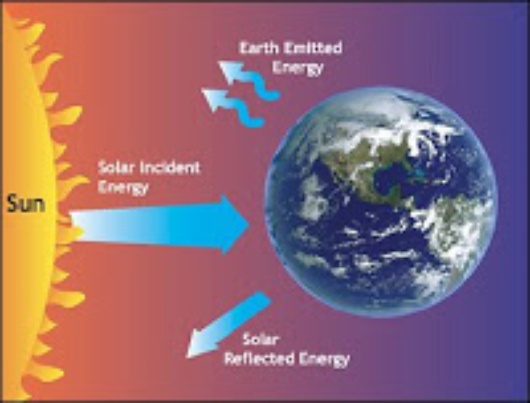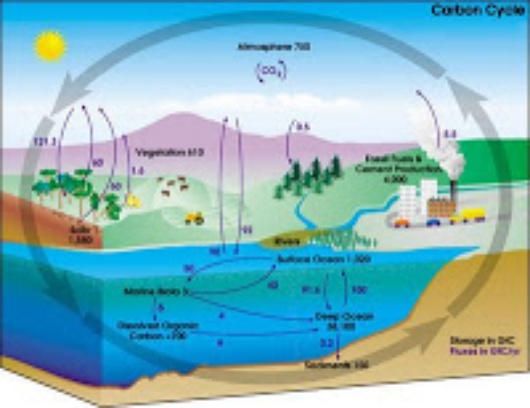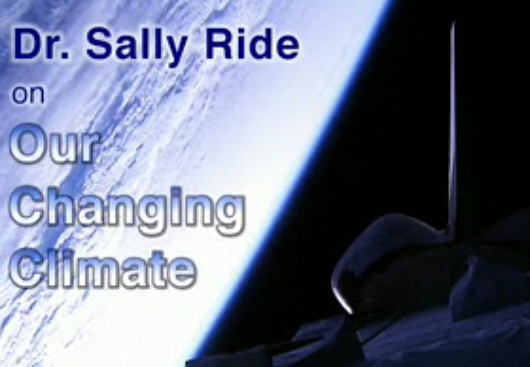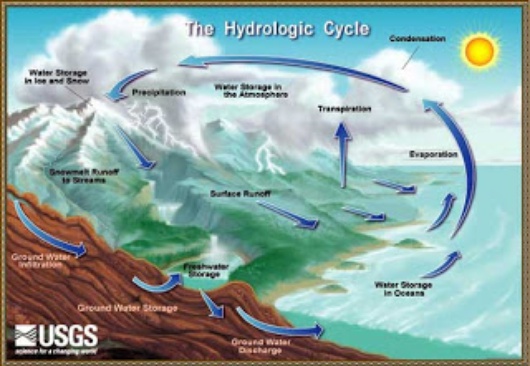The Earth's Atmosphere: Weather is not climate
Published on
The argument and repeated by naive readers is On the face of it, this sounds like a sensible question. often made by deniers "They (scientists), cannot even predict the weather for more that three days, so how can they know what would happen in 50 or 100 years? The physics of planetary temperature is a very different problem, however, than weather prediction.
It is actually much simpler than understanding the dynamics of air masses, which are what govern the weather. Determining planetary temperature is a more straightforward problem: calculating the "energy budget" of the planet.
As an illustration, imagine two objects, a white pool ball and a source of heat such as a 100W bulb. If you move the ball closer and closer to the source of heat, its temperature will increase. You may have to wait a bit after each move, to overcome thermal inertia, but eventually the ball heats up to a temperature at which the energy absorbed by the ball is radiated back into space. The ball has then reached dynamic equilibrium and its energy budget is balanced.Pool balls and light bulbs
When you look at the temperatures of the planets you see a progression from cold to hot as we approach the sun. There are some small deviations from the temperature expected solely on the basis of distance. To understand those with our illustration, substitute a ball painted black. It will absorb more heat and its temperature will be higher.
This higher temperature means an increase in the radiation of the extra absorbed energy. That is the greenhouse effect. This is a simple description of a "balanced energy budget." More complexly stated, the composition of the planetary atmosphere, represented by the color of the ball in our example, changes its "albedo," the ratio of energy reflected to energy absorbed.
Obviously, the calculation of the energy budget for a real planet is a bit more complex. Our planet both rotates and orbits the sun . There are seasons. The intensity of sun's output itself is changing, as is the amount of sunlight reaching particular parts of the earth at any given time. Bodies of water, which act as heat reservoirs, are being filled and emptied, the effect of thermal inertia.
Now imagine thousands of ants, living on the surface of a ball which has gray splotches. They will run around, often in response to the local temperature, in an unpredictable, chaotic manner. Their chaotic motion will not affect the energy budget, the average temperatures, or climate of the ball. These ants represent the weather, the motion of air masses, precipitation, and the evaporation of water.Introducing the ants
The ants also can represent the behavior of life, which has no effect on the energy budget, unless and until the ants start painting the surface of the planet a different shade of gray. That has happened in the history of our planet several times. It happened when life started, when animals appeared, and it has been happening again, since industrial revolution.
Let's abandon the pool balls and ants for a look at the Earth:
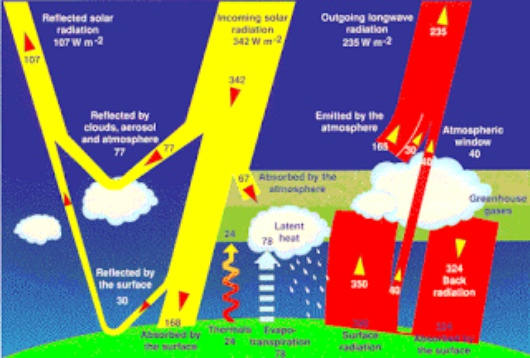 c2s
c2s
The configuration of the sun, Earth, and dust clouds in space keep changing when observed on geological time scales. These changes produce semi-periodic changes of climate , ice ages and interglacial periods. Beyond that, the activity of the sun itself has several irregular cycles.
It is important to understand that climate models are not attempting to predict either weather or climate. Both are chaotic systems, in the mathematical sense, unpredictable in the long run. Models of climate are calculating the energy budget of the planet. They are describing what happens to the energy which comes from the sun. While some models of the processes within the sun and other stars do exist, they only predict the long term fate of stars. They do not predict the irregular fluctuations and cycles of their output.
From an excess of O2 to an excess of CO2
During the early years of our planet, the energy content of the Earth was increasing, the converse of our situation now. Nor were the ratios of gasses in the atmosphere stable. Rather, the concentration of oxygen in the atmosphere . This process had been going on since the Earth cooled enough for water vapor to condense and form oceans, followed by life appearing there in the form of microbes. The concentration of oxygen . How and why did this happen?was growing dramatically peaked at 30%
As we all learned at school, plants use solar energy, water from the soil, and carbon dioxide in a process called , which releases oxygen into the atmosphere. In that splendid process, plants also reduce the energy-poor compounds (oxides such as water and CO2) into energy-rich compounds (wood, sacharides such as sugars and cellulose.) and are eventually transformed into . This process flourished uninhibited until a half billion years ago, when animals and multi-cellular organisms which used oxygen appeared. After many milenia and events, , the atmosphere stabilized at .the Cambrian “explosion”the rise of new species and the extinction of others ratios of 20% oxygen and 256 ppm of CO2
It remained stable even when, some 10 million years ago, a new animal started walking on two legs and invented fire. However, about 350 years ago these bipeds invented the steam engine and started converting the accumulated fossil fuels back into oxides, to CO2 (Carbon dioxide) and H2O (water), at an ever increasing rate. c4v
Writings of that period, even as late as the early 20th century, speak exuberantly of "progress" and see the supply of such energy as inexhaustible. No one apparently could envision the rapid growth of the world's population coupled with the explosion of devices engineered to specifically to use those energy supplies stored so long ago. In fact, many of us are still reluctant to face the fact that the end of these sources is in sight.
means "click for video". The thin blue ribbon you see at the edge in this photo is the Earth's atmosphere. In this five-minute video, American astronaut Dr.Sally Ride describes her first impression of that blue ribbon in 1983. Illustrated lavishly with photos from space taken then and in the 25 years since, we see clear changes in the Earth's surface.The thin blue ribbon
The temperature, as shown in , increased by a half degree centigrade in that time. A half degree is a small change, when compared to swings of a season, the weather, or latitude, but over vast areas and time periods it leads to significant changes, as shown in the video. Do look at it and leave a commentDr. Ride is optimistic. Are you? In our next post, we will examine what humans can do about these problems, what was tried in the past and failed, what new solutions are being proposed.
Posted by Petr F.
at
Labels:
The water cycle.
References
Qualitative theory behind a simple model Unless you are totally allergic to even simple equations (the Stefan-Boltzman law), look at this elegant, "order of magnitude" estimate of GH effect.0 comments
Links to this post
 EUdebate2009 climate EUdebate2009 water cycle
EUdebate2009 climate EUdebate2009 water cycle
What about that 800 lb gorilla?
In a comment to the ( January 20 2009, 14:36 by Ken)Ken says: " The vast majority of the public believes that C02 controls all of the greenhouse effect, when in reality water vapour is the dominant contributor. It is the 800 lb gorilla, not C02. Which begs the question: Why is water vapour omitted from climate modelling? Omitting water vapour is like working out the moon's orbit and omitting gravity. It's impossible, but that is what is being done with climate models. Amazing."
Indeed, water vapor is the major greenhouse gas (GHG) in the atmosphere and responsible for 60% of the natural GHG warming .
The water cycle is complex and has several opposing effects. Almost 90% of the global evaporation occurs from the oceans, reducing their temperature by evaporative cooling. Clouds, snow, and ice cover increase the albedo of the planet , reducing the amount of heat. Water vapor is also increasing absorbed heat through the GH effect.
Before we look at these effects in more detail, I will address the comment, using Ken's parable: This big and complex gorilla, the water cycle, is controlled by a small child, its cousin, called the CO2 cycle. The key term here is "residence time" (RT). For water vapor in the atmosphere the average residence time is nine days. What does this mean?
Imagine building a facility which will vaporize vast amounts of water and release it into the atmosphere. The absorption of heat will increase due to stronger GH effects. In a few days it will rain, and all the water which you added will be back in the rivers and oceans.
Our planet is unique in the known universe for having water under natural conditions in all three phases: as a gas, a liquid, and a solid. Carbon dioxide, in contrast, does not behave this way.
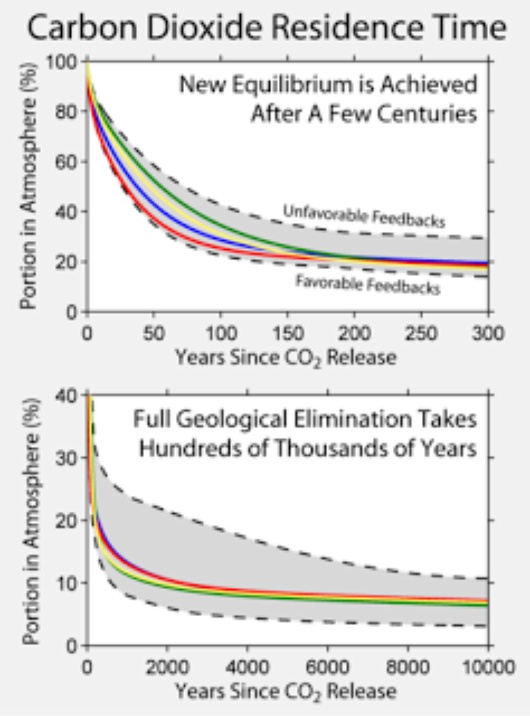 c4s
When you add CO2 to the atmosphere, you warm the planet a little bit. The effect is amplified because warmer air holds more water vapor. So raising or lowering CO2 acts as a throttle to raise or lower the really important greenhouse gas, water or H2O.
c4s
When you add CO2 to the atmosphere, you warm the planet a little bit. The effect is amplified because warmer air holds more water vapor. So raising or lowering CO2 acts as a throttle to raise or lower the really important greenhouse gas, water or H2O.
Like water, carbon dioxide (CO2) is exchanged between the atmosphere, land, and oceans, in the carbon cycle. In contrast to water, its residence time in the atmosphere is hundreds of years. Thus the concentration of CO2 can be treated as an input variable in the models. One can set the CO2 level or its rate of increase to a given value and let the model calculate the effects. The level of water in the atmosphere can not be treated the same way because of its short residence time.
Mathematically speaking, the concentration of CO2 can be treated as independent parameter. In such a simulation run, the model is calculating "what the temperature will be" at given level of CO2 or at a given rate of increase. These different runs are the varied scenarios being considered. The concentration of water is a dependent variable; it should not be forced. The model will calculate its value as determined by the dynamical equilibrium of all cycles. That is the reason you hear more about CO2 when different scenarios are being described.
So, water is not ignored in the models. Its effect was recognised very early in history of the models of climate. In 1862 the English physicist Tyndall wrote that for Earth "water vapor 'is a blanket more necessary to the vegetable life of England than clothing is to man. Remove for a single summer-night the aqueous vapour from the air... and the sun would rise upon an island held fast in the iron grip of frost.' Tyndall needed no equations, but only simple logic, to see, what many since him overlooked: it is at night that the gases are most important in blocking heat radiation from escape, so it is night-time temperatures that the greenhouse effect raises the most."
It was Tyndall first, and then Swedish physicist Arrhenius (1859 - 1927), who created first simple climate models. They incorporated the effects both oxides, of H2O and CO2 .
Arrhenius, realized that the concentration of CO2 was rising due to the burning of fossil fuels. This was at the beginning of the Industrial Revolution. He figured that if industry continued to burn fuel at then current rates, it would take thousands years for the CO2 level to rise high enouh to cause concern. As use of fossil fuels has "progressed," this estimate had to be dramatically revised.
The quotes cited above are from a fascinating book, "The Discovery of Global Warming," which reads like a detective story. Available as a 200 page paperback, on CDrom, or from the Web as pdf files for free, it is highly recommended reading.
There are other GHG gases as well as circulation models of other compounds, but those of energy, water, carbon, oxygen and carbon dioxide are the most important for models of climate. As scientists are getting more data from satellites designed to monitor GHG gases and are refining the physical basis of models, the ability to understand the changes and their causes is improving.
We should remind ourselves that climate models do not actually predict the future. The future depends on economic and political decisions. In posing "what if" questions, models can help us make those decisions.
It is important that before we spend billions of Euros on the environmental tax on carbon emission, on the ETS tax, we have a high degree of confidence in the predictions of these models.
Posted by Petr F.
at
Labels:
References
Simple model applet Here is a short summary of the first models of climate. Qualitative theory behind a simple model Unless you are totally allergic to even simple equations (the Stefan-Boltzman law), look at these estimates. Slightly more complex and more detailed description of the greenhouse effect.0 comments
Links to this post
 EUdebate2009 climate EUdebate2009 water_cycle GHG
EUdebate2009 climate EUdebate2009 water_cycle GHG




